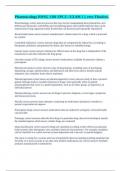Pharmacology RNSG 1301 EPCC: EXAM 1 || very Flawless.
Biotechnology correct answers process that may involve manipulating deoxyribonucleic acid
(DNA) and ribonucleic acid (RNA) and recombining genes into hybrid molecules that can be
inserted into living organisms (often Escherichia coli bacteria) and repeatedly reproduced
Brand (trade) name correct answers manufacturer's chosen name for a drug, which is protected
by a patent
Controlled substances: correct answers drugs that are categorized by federal law according to
therapeutic usefulness and potential for abuse; also known as scheduled drugs
Generic name correct answers chemical or official name of the drug that is independent of the
manufacturer and often indicates the drug group
Over-the-counter (OTC) drugs correct answers medications available for purchase without a
prescription
Pharmacoeconomics correct answers costs of drug therapy, including costs of purchasing,
dispensing, storage, administration, and laboratory and other tests used to monitor patient
responses; also considers losses due to expiration
Pharmacogenomics (also known as pharmacogenetics) correct answers study of how a person's
genetic heritage leads to variable responses to drugs; more generally refers to genetic
polymorphisms that occur in a patient population, such as an ethnic group, as opposed to an
individual person
Pharmacotherapy correct answers use of drugs to prevent, diagnose, or treat signs, symptoms,
and disease processes
Placebo correct answers inert substance containing no medication and given to reinforce a
person's expectation to improve
Prescription drugs correct answers medications that are ordered in writing by a licensed health
care provider
Prototype correct answers often the first drug of a particular drug class to be developed; usually
the standard against which newer, similar drugs are compared
Drug classification correct answers Drugs are classified according to their effects on particular
body systems, their therapeutic uses, and their chemical characteristics. For example, morphine
can be classified as a central nervous system depressant and a narcotic or opioid analgesic.
The nurse is caring for a woman who has strong beliefs about not putting anything unnatural into
her body. It is most accurate to say that most modern medications are correct answers Synthetic
products manufactured in laboratories
, The nurse is taking care of a man who is confused about the different medications he is
prescribed. He notes that some of the drug names have changed over the course of time he has
been taking them. When counseling him, it is most important to keep the following statement in
mind correct answers A prototype drug is the standard by which similar drugs are compared.
Categories of Controlled Substances (Schedule I) correct answers Drugs that have no accepted
medical use, have lack of accepted safety, and have high abuse potentials: heroin, lysergic acid
diethylamide (LSD), 3,4-methylenedioxy-methamphetamine (MDMA or ecstasy), mescaline,
and peyote.
Categories of Controlled Substances (Schedule II) correct answers Drugs that are used medically
and have high abuse potentials: opioid analgesics (e.g., codeine, hydromorphone, methadone,
meperidine, morphine, oxycodone), central nervous system (CNS) stimulants (e.g., cocaine,
methamphetamine), and barbiturate sedative-hypnotics (e.g., pentobarbital).
Categories of Controlled Substances (Schedule III) correct answers Drugs with less potential for
abuse than those in Schedules I and II, but abuse of which may lead to psychological or physical
dependence: androgens and anabolic steroids, some depressants (e.g., ketamine, pentobarbital),
some CNS stimulants (e.g., methylphenidate), and mixtures containing small amounts of
controlled substances (e.g., codeine, barbiturates not listed in other schedules). These drugs and
substances have an accepted medical use in the United States.
Categories of Controlled Substances (Schedule IV) correct answers Drugs with an accepted
medical use in the United States but with some potential for abuse: benzodiazepines (e.g.,
diazepam, lorazepam), other sedative-hypnotics (e.g., phenobarbital, chloral hydrate), and some
prescription appetite suppressants (e.g., phentermine).
Categories of Controlled Substances (Schedule V) correct answers Products containing moderate
amounts of controlled substances. They may be dispensed by the pharmacist without a
physician's prescription but with some restrictions regarding amount, record keeping, and other
safeguards. Included are cough suppressants containing small amounts of codeine and
antidiarrheal drugs, such as diphenoxylate and atropine (Lomotil).
What does the DEA do? correct answers The Drug Enforcement Administration (DEA) enforces
the Controlled Substances Act. Individual people and companies legally empowered to handle
controlled substances must register with the DEA, keep accurate records of all transactions, and
provide for secure storage. The DEA assigns prescribers a number, which they must include on
all prescriptions they write for a controlled substance.
Medication-assisted treatment (MAT) correct answers An approach known as medication-
assisted treatment (MAT) may be used in the management of substance abuse disorders. MAT
involves the use of FDA-approved medications in combination with counseling and behavioral
therapies.




